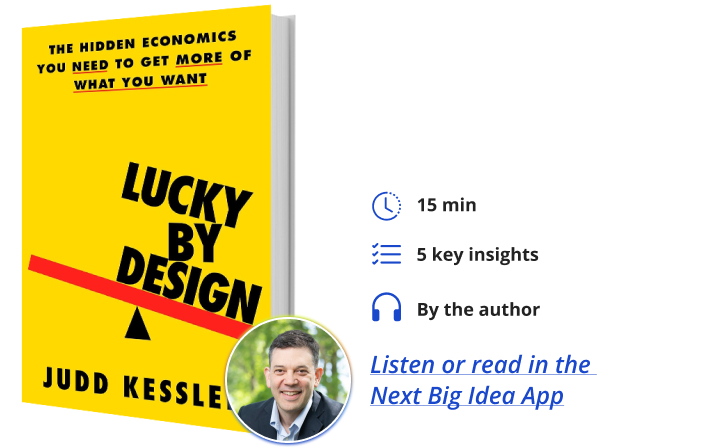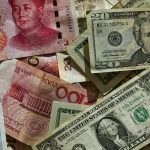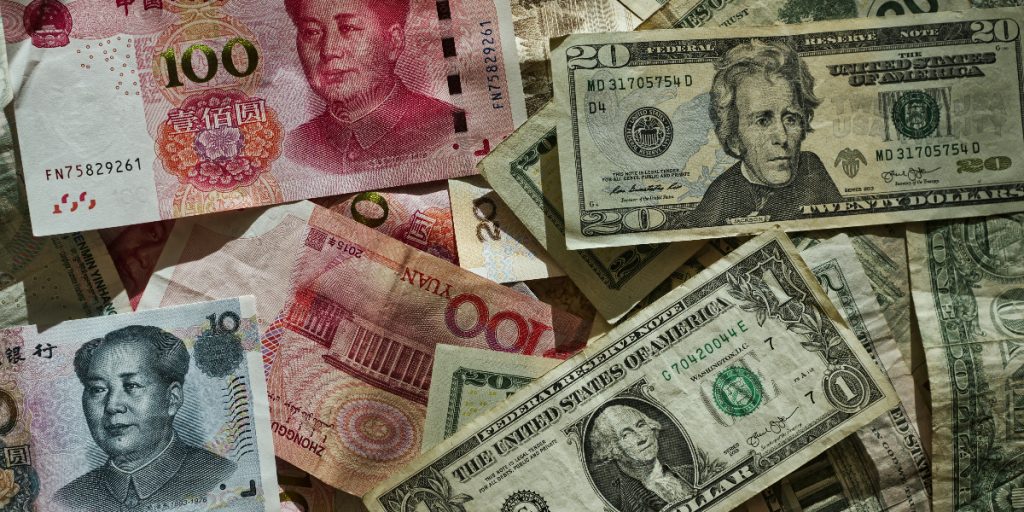Below, Judd Kessler shares five key insights from his new book, Lucky by Design: The Hidden Economics You Need to Get More of What You Want.
Judd is an award-winning professor of economics at the Wharton School of the University of Pennsylvania. His research and writing have been featured in leading media, such as The New York Times, The Wall Street Journal, Scientific American, and Harvard Business Review, among others. For his work on organ allocation, Kessler was named one of the “30 under 30” in Law and Policy by Forbes. He has been researching market design for the past 15 years.
What’s the big idea?
Life is full of hidden markets quietly deciding who gets what—and learning their rules is the real competitive edge. See the system, play it strategically, and you can manufacture your own luck.

1. You are constantly playing in hidden markets all around you.
Economists think about the world as a bunch of markets. In each market, people are trying to get something that they want. But we have a problem—scarcity. There is rarely enough of what people want to just give it to everyone. So, we need a way to decide who gets access to the scarce resource and who does not.
We often decide who gets what by letting the price rise. As the price rises, a bunch of people decide that paying such a high price isn’t worth it and they leave the market. (Fewer people wanting something as the price rises is so reliable that economists call it a law of demand.)
I call markets that use prices to decide who gets what visible markets. They’re visible because it’s easy to see them. And playing in them is also easy: you simply decide whether something is worth the price and then buy it (or not).
But scarcity is not always resolved with prices. Some things are doled out by hidden markets that do not rely on prices to decide who gets what. These hidden markets are harder to see and more complicated to play in, but they are all around you.
Sometimes prices exist but are set too low to resolve the scarcity: Taylor Swift sold tickets to her most recent tour, the Eras Tour, for an average of $204, but some tickets were as low as $49 each. At those prices, many people would have happily bought each ticket. Some restaurants are so popular that it’s nearly impossible to get a table. New iPhones used to fly off the shelves the day they were released. Fad toys (most recently the Pop Mart product Labubus) may be incredibly hard to get your hands on.
“Scarcity is not always resolved with prices.”
Other times, we decide not to use prices at all: government benefits like public housing, seats in public schools, and library books are not sold to the highest bidder. We don’t let price decide who gets life-saving donor organs or access to the last hospital bed or ventilator.
In these cases, we still resolve scarcity: some people get the tickets, reservations, products, government benefits, and life-saving medical care while others do not. Those are the hidden markets all around you. They have their own rules, and you need to learn them.
2. You need to learn the market rules.
Every hidden market has its own set of market rules. Your first step toward success in hidden markets is learning them. What are the types of market rules?
One class is based on the principle “first-come, first-served.” With first-come, first-served, whoever gets to a product first gets to claim it. But while this principle might sound simple, the market rules it generates take three very different forms.
For example, first-come, first-served market rules can take the form of a race. If you want a reservation at The French Laundry, a world-renowned restaurant with three Michelin stars in the Napa Valley of California, you need to secure a reservation for one of its 17 tables in a first-come-first-served race. All reservations for a given month are offered online simultaneously—if you want to eat there in November, you need to be ready to click quickly at 10 am on October 1st.
First-come, first-served market rules can also take the form of a waiting list or line. People who need a life-saving kidney transplant can join a multi-year waiting list for a deceased donor organ through their local transplant center. The longer that they have been waiting, the higher their priority for an organ when it becomes available.
If you want to see a masterpiece like the ceiling frescos of the Sistine Chapel, buy high-end apparel at a clothing drop, or just make your way through airport security, you’ll be standing in a first-come, first-served line. These first-come, first-served market rules all reward arriving early or waiting the longest. But other market rules operate completely differently.
Another class of market rules uses lotteries to decide who gets what. The New York City Summer Youth Employment Program gives 100,000 jobs to youth each summer, but still has to turn away tens of thousands of kids. They use a lottery to decide who gets a job and who does not. Lotteries also provide access to spots in the London Marathon, license plates in Beijing, seats in charter schools, and tags to hunt big game.
“Every hidden market has its own set of market rules.”
Another class of market rules involves centralized clearinghouses, where you must rank your preferences: telling an algorithm your first choice, second choice, and so on. This is how we decide which kids go to which elementary schools in New York City, how doctors are assigned to residency programs, and how college admissions work in China.
Dating markets, labor markets, and private school admissions markets operate with different market rules. I call these markets “choose-me” markets because you are choosing someone, a firm, or an academic institution. But for a match to take place, you must also be chosen.
Every hidden market has its own specific set of market rules. To succeed in a given market, you need to learn them. Once you know how the game is played, you can develop a strategy to win.
3. You might want to settle for silver.
Once you have figured out the rules of the game, you can develop an optimal strategy to get what you want. Across many hidden markets, one common strategy you might want to play is what I call “settling for silver.” This strategy requires acting like something less desirable—something that is not your real first choice—is at the top of your list.
Why might you want to play this strategy? Imagine you’re in a first-come-first-served race, like for a restaurant reservation at The French Laundry. Say you really want to have dinner there on a Saturday night in November. All the reservations are going to be released on October 1st at 10 am. And when they’re released, you will race to click on a particular reservation time. Which time should you click first?
Your real first choice might be 7:30 pm on Saturday. You might decide to click that time slot first. I call playing that strategy—trying to get the thing you actually want the most—“going for gold.” The problem with going for gold is that it’s risky. What you want is often popular with many other people. So, when you’re racing for that highly desirable reservation slot, you’re likely competing with many other diners who want the same thing as you.
Settling for silver would mean pretending that an earlier dinner reservation, say 5 pm or even 4:30 pm, is your first choice. If you prefer getting a reservation at 4:30 pm to not getting to eat at the restaurant at all, settling for silver might be the right strategy for you. Since many fewer people will be racing for a 4:30 pm reservation, you are much more likely to get it.
The same logic applies in markets with much higher stakes. Many applicants to private colleges in the United States choose to apply early decision, which commits them to attending the school if they’re admitted. Since an early decision application comes with a binding commitment to attend, you can only apply early decision to one school. Colleges like it when you commit to them, so they reward early decision applicants with a higher chance of admission.
“This strategy requires acting like something less desirable—something that is not your real first choice—is at the top of your list.”
So, what school should someone apply to early? They might be tempted to apply to a reach school early decision. This could be the right move. But if the candidate’s chance of admission is exceedingly slim, then even if it’s their top choice, it might be suboptimal to apply there early. Rather than trying to go for gold, they might do better settling for silver by applying to a less selective school early. This way, they can take advantage of their improved admissions chances at their second-, third-, or fourth-choice school.
4. You might want to double dip and multi-list.
Another strategy that comes up regularly in hidden markets is what I call “double dipping.” This strategy involves simultaneously playing in a market multiple times.
Double dipping is a common strategy in markets that use lotteries. The U.S. Diversity Visa Lottery has historically offered visas to those from countries that don’t send many immigrants to the U.S. The program selects applicants by lottery and gives winners a chance to come to the country and get a green card. But the lottery lets you bring your whole family if you win, so a married couple does better if they each submit an entry: if either of them wins, the whole family gets to come to the U.S.
When you enter a theater ticket lottery, you can usually enter for a chance to win two tickets. If you want to go to the theater with a friend, then you should double dip. You should both enter the lottery, effectively doubling your chances of seeing a show.
Allowing double dipping can be good for the efficiency of the lottery overall. People who are more motivated are more likely to put in the extra effort needed to play this strategy. Allowing double dipping gives people who care more about winning a higher chance of success.
A related strategy is called “multi-listing.” If there are a limited number of daycare slots in your city and lots of families who want them, spots may be offered on a first-come, first-served waiting list. In that case, you might want to add yourself to waiting lists at multiple daycare centers to increase the chance that you will have secured a spot for your tot when you need it.
And people in need of life-saving organ transplants may decide to multi-list by adding themselves to organ waiting lists through transplant centers in different regions. Since being affiliated with a transplant center closer to a deceased donor organ increases the chance you get offered it, being on waiting lists at multiple transplant centers increases the number of organs you get offered. In that case, multi-listing could save your life.
5. You are a market designer!
Many hidden markets are designed by others, and you just have to learn the rules to try to get what you want. But there are also hidden markets that you control, like the hidden market for your time and attention or the hidden markets for household resources.
You get to decide which emails you respond to promptly, which friends to call back and which to ignore. At home, you get to decide how to allocate everything from financial resources to the television remote to desserts for your kids. In these cases, you get to set the market rules.
As a market designer, you can prioritize the three Es in your hidden markets:
- Efficiency: Not wasting resources and giving resources to people who value them most.
- Equity: Distributing resources as equally as possible to market participants.
- Ease: Letting market participants be honest about what they want and not putting them through an ordeal to get it.
Good market rules strive to get as close as possible to achieving all three.
Efficiency might mean prioritizing email responses where your prompt reply will be most helpful to the recipient: perhaps someone who is actively working on a project and will be more productive once they receive your feedback. It could also mean devoting your limited time to whatever your highest-return activity is today, rather than to a recurring meeting you put on your calendar months ago, which can—and probably should—be skipped.
Equity might require giving people whom you want to treat fairly the same amount of time, attention, and resources, rather than (intentionally or unintentionally) favoring the one who is most demanding.
Finally, in some markets, we can make more of a scarce resource by how we prioritize access to it. In some countries, people who register as organ donors receive higher priority for organs if they ever need one. Similarly, during the Covid-19 pandemic, we prioritized medical treatment—like the last hospital bed or ventilator—for medical professionals serving on the front lines. These priority systems help ensure that we allocate more of the scarce resources we have. The same logic applies to your time and attention. Prioritizing some of it for yourself (perhaps for self-care) can also mean there’s also more to go around.
Enjoy our full library of Book Bites—read by the authors!—in the Next Big Idea App:































